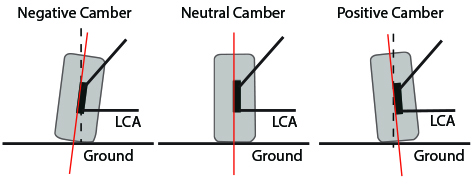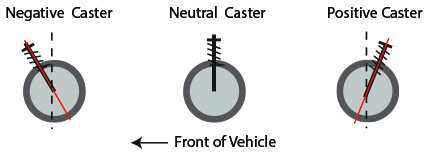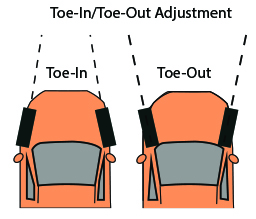One of the most important aspects of suspension set-up, regardless of whether the car in question is a daily-driver, weekend warrior, or full-fledged race car, is ensuring that front end alignment is in spec. A proper alignment not only results in a vehicle that steers straight and offers safe, superior handling, but also helps maximize tire life. It’s also necessary any time front suspension repairs or upgrades are performed, such as replacing struts, springs, tie rod ends, idler arms, or installing adjustable control arms.
When front end alignment is being analyzed, there are three different specifications that must be checked and corrected as necessary: CAMBER, CASTER, and TOE. Camber and caster are effectively angles that are measured in degrees, while TOE is measured in inches. Specifications for each may be found in most popular auto repair manuals, or using Specialty Products Company’s new AlignGuide app for Apple and Android (for 1985-up vehicle models only).
CAMBER is the tilt of the tire viewed from the front. If the tops of the tires lean in toward the car, for example, a negative camber condition exists. On the other hand, if the tops of the tires tilt out from the center of the car, a positive camber condition is present. Optimizing camber can help achieve maximum speed and prolong tire life. If camber falls out of spec, irregular tire wear and compromised braking can result.

To understand CASTER, picture an imaginary line that runs from the upper to the lower ball joint with caster being the forward or backward tilting of the imaginary line. If, for example, the imaginary line tilts toward the back of the car at the upper ball joint, a positive caster condition would exist. On the other hand, if the imaginary line tilts toward the front of the car, it would cause negative caster. While most cars feature a small amount of positive caster to provide directional stability, too much positive caster can actually cause steering effort to become difficult. Negative caster, on the other hand, provides eased steering but can allow the car to wander.

Oval track and road race teams often utilize a caster/camber gauge to determine proper caster and camber. The unit is attached directly to the spindle by the user with an adapter and is used in conjunction with turn plates that allow the wheels to be turned to precise angles. While these specialized tools provide exceptional accuracy, they are geared to serious oval track or road racers that are commonly subjected to on-track mishaps and the associated damage, and are not cost-effective for the performance enthusiast that requires only periodic checks.
Previously, most enthusiasts would simply take their car to an auto repair or chassis shop that had the capability to perform front end alignments until the recent availability of affordable, adjustable camber/caster gauges, such as the units offered by Specialty Products Company and Longacre Racing. These portable, do-it-yourself style tools allow checking camber and caster in the home garage, shop, or even at the track. They also eliminate the need for costly turn plates and spindle mount adapters.
The FasTrax Adjustable Camber/Caster Gauge, offered by Specialty Products Company, combines a camber/caster gauge and wheel mount to offer quick, accurate alignment checks. The tool, which is available to fit 13″-18″ (SPP91000) or 17″-22″ (SPP91010) wheels, features three guide studs that grasp the inner or outer lip of the wheel to allow hands-free camber/caster readings. The gauge vial provides camber readings on the left side, and caster readings on the right. The vial block additionally includes a 15° angled end to allow accurate caster readings, eliminating the need for costly turn plates. Once camber and caster has been checked and adjusted as necessary, toe may be checked using the optional toe adapter set (SPP91100) that attaches directly to the FasTrax.

Longacre Racing’s Quick Set Adapter with camber/caster gauge (LON52-78274) features a similar design and function, however, is engineered as a higher end model as the wheel adapter and camber/caster gauge are constructed from precision, CNC-machined billet aluminum. Rather than being secured to the wheel, the Quick Set Adapter butts up against it and only needs to be held when reading camber/caster angles.
Regardless of the chosen shop or method of alignment, ensure that all tire pressures are set, and if possible, add weight to the driver’s seat to simulate driver weight. The Allstar Scale Buddy (ALL13115), a water filled bladder that weighs up to 100 lbs., is designed for this exact purpose. The bladder may be filled and emptied in the car using a standard garden hose.
Once camber and caster has been checked, upper control arm shim usage may be adjusted if either are out of spec. Shims are available from Allstar Performance, in 1/16″ (ALL60200) or 1/8″ (ALL60201) thicknesses. It’s important to note that both camber and caster must be re-checked each time a shim change has been made.
TOE is the position of the tires pointed straight ahead and viewed from the top of the car, as either toe-in or toe-out. Toe-in is the condition when the front edge of the tires point inward toward the engine, while toe-out is when the front edges of the tires are pointed outward. Toe, which is adjustable at the tie rod or rack ends, may be checked using toe plates, a toe bar, or a tire scribe.

Toe plates, used in pairs, are available from Allstar Performance (ALL10119). Prior to using toe plates, air up the front tires, ensuring that there are no bulges at the bottom of that would compromise accuracy. The toe plates are simply placed against the outside edge of the front tires, allowing measurements to be taken from the front and rear of the tires. Each toe plate includes notches to aid measuring. If the rear measurement is 1/8″ less than the front, for example, that would signify that the car has 1/8″ toe-out.
Yet another method of checking toe is using a Toe Bar, available from Longacre Racing (LON52-79622), which takes measurements from the outside of the tires. Proceed by sliding the toe bar under the car and adjust the rod so that it has even pressure on the front side of sidewall. Repeat at the rear sidewall with the difference being the amount of toe. An 1/8″ larger measurement at the rear, for example, would result in 1/8″ toe-out.
Probably the most accurate method of checking toe is by utilizing the tire scribe method, which removes variables including side wall run out, tire bulge, or bent wheels. Using a tire scribe, such as the billet aluminum Longacre Racing unit (LON52-79610), begin by simply spinning the tire against the scribe so that it scribes a line completely around the tire. Repeat the procedure on the opposite front tire. Continue by measuring from the front of each tire using the scribe line for reference. Finish by measuring from the rear of each front tire, again using the scribe line for reference. If, for example, the front measurement is 1/8″ greater than the rear, the result is 1/8″ toe-out. Longacre also offers a special toe gauge (LON52-79620) that allows a single person to take measurements after the tires have been scribed.
Another key factor that shouldn’t be overlooked is whether the car is subject to bump steer, a condition that can cause hazardous steering conditions due to improper steering angles, and is particularly common to vehicles with altered ride heights. It’s important that the working angle of the lower control arm and the tie rods be as parallel as possible. If not, they may be corrected by using popularly available “bump steer kits”, available from manufacturers including Allstar Performance, QA1, Steeda, and UMI Performance. The kit utilizes special outer tie rods, heim ends, and a selection of spacers of varying thickness that install between the steering arm and outer tie rod.
Circle track racers pay special attention to the condition and often use specialized bump steer gauges in an effort to achieve “zero bump”. Manufacturer’s including Longacre (LON52-79005 Standard or LON52-79015 Digital Model) and Tanner (TAN1200-BSG) offer bump steer gauges that can measure the condition up to 0.001″. Allstar Performance offers adjustable center links (ALL56330 or ALL56331) that are used in conjunction with special offset inserts (ALL99088) to allow precise bump steer correction. Following any method of bump steer correction, toe should be checked and corrected as necessary.
While often taken for granted until a steering or handling issue arises, keeping front end alignment in check will not only help provide safe, effective handling but also ensure maximum tire life